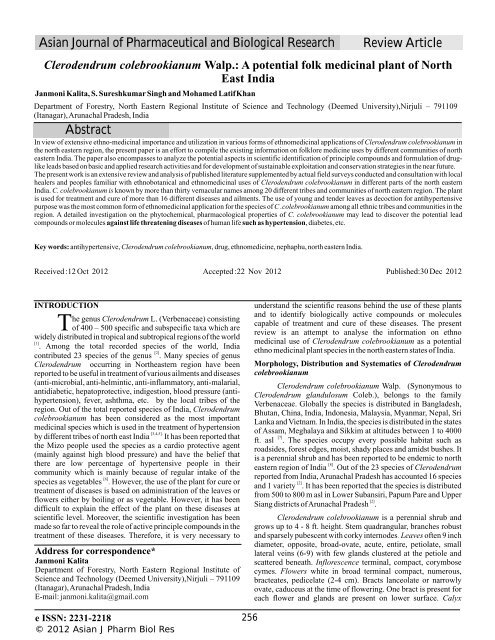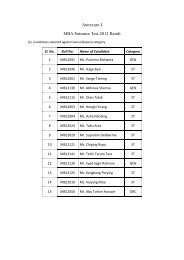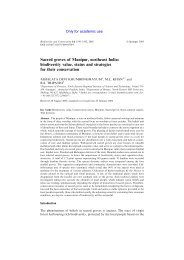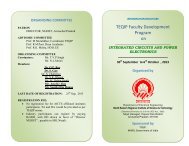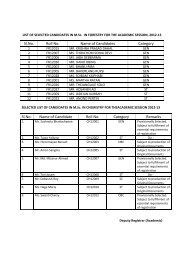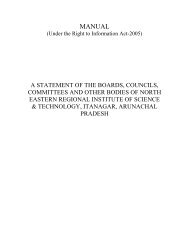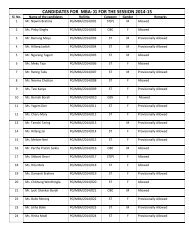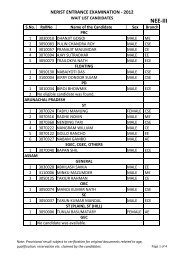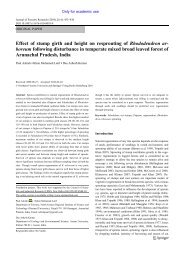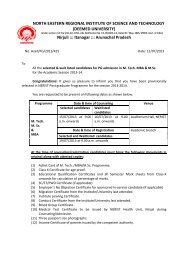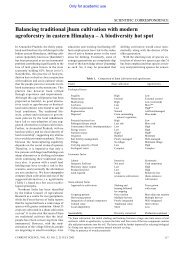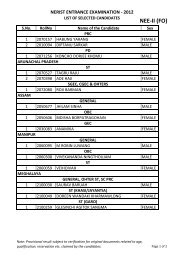Clerodendrum colebrookianum Walp. A potential folk ... - NERIST
Clerodendrum colebrookianum Walp. A potential folk ... - NERIST
Clerodendrum colebrookianum Walp. A potential folk ... - NERIST
Create successful ePaper yourself
Turn your PDF publications into a flip-book with our unique Google optimized e-Paper software.
Asian Journal of Pharmaceutical and Biological Research<br />
<strong>Clerodendrum</strong> <strong>colebrookianum</strong> <strong>Walp</strong>.: A <strong>potential</strong> <strong>folk</strong> medicinal plant of North<br />
East India<br />
Janmoni Kalita, S. Sureshkumar Singh and Mohamed LatifKhan<br />
Department of Forestry, North Eastern Regional Institute of Science and Technology (Deemed University),Nirjuli – 791109<br />
(Itanagar), Arunachal Pradesh, India<br />
Abstract<br />
Review Article<br />
In view of extensive ethno-medicinal importance and utilization in various forms of ethnomedicinal applications of <strong>Clerodendrum</strong> <strong>colebrookianum</strong> in<br />
the north eastern region, the present paper is an effort to compile the existing information on <strong>folk</strong>lore medicine uses by different communities of north<br />
eastern India. The paper also encompasses to analyze the <strong>potential</strong> aspects in scientific identification of principle compounds and formulation of druglike<br />
leads based on basic and applied research activities and for development of sustainable exploitation and conservation strategies in the near future.<br />
The present work is an extensive review and analysis of published literature supplemented by actual field surveys conducted and consultation with local<br />
healers and peoples familiar with ethnobotanical and ethnomedicinal uses of <strong>Clerodendrum</strong> <strong>colebrookianum</strong> in different parts of the north eastern<br />
India. C. <strong>colebrookianum</strong> is known by more than thirty vernacular names among 20 different tribes and communities of north eastern region. The plant<br />
is used for treatment and cure of more than 16 different diseases and ailments. The use of young and tender leaves as decoction for antihypertensive<br />
purpose was the most common form of ethnomedicinal application for the species of C .<strong>colebrookianum</strong> among all ethnic tribes and communities in the<br />
region. A detailed investigation on the phytochemical, pharmacological properties of C. <strong>colebrookianum</strong> may lead to discover the <strong>potential</strong> lead<br />
compounds or molecules against life threatening diseases of human life such as hypertension, diabetes, etc.<br />
Key words: antihypertensive, <strong>Clerodendrum</strong> <strong>colebrookianum</strong>, drug, ethnomedicine, nephaphu, north eastern India.<br />
Received :12 Oct 2012 Accepted :22 Nov 2012 Published:30 Dec 2012<br />
INTRODUCTION<br />
he genus <strong>Clerodendrum</strong> L. (Verbenaceae) consisting<br />
Tof 400 – 500 specific and subspecific taxa which are<br />
widely distributed in tropical and subtropical regions of the world<br />
[1]<br />
. Among the total recorded species of the world, India<br />
[2]<br />
contributed 23 species of the genus . Many species of genus<br />
<strong>Clerodendrum</strong> occurring in Northeastern region have been<br />
reported to be useful in treatment of various ailments and diseases<br />
(anti-microbial, anti-helmintic, anti-inflammatory, anti-malarial,<br />
antidiabetic, hepatoprotective, indigestion, blood pressure (antihypertension),<br />
fever, ashthma, etc. by the local tribes of the<br />
region. Out of the total reported species of India, <strong>Clerodendrum</strong><br />
<strong>colebrookianum</strong> has been considered as the most important<br />
medicinal species which is used in the treatment of hypertension<br />
[3,4,5].<br />
by different tribes of north east India It has been reported that<br />
the Mizo people used the species as a cardio protective agent<br />
(mainly against high blood pressure) and have the belief that<br />
there are low percentage of hypertensive people in their<br />
community which is mainly because of regular intake of the<br />
[6]<br />
species as vegetables . However, the use of the plant for cure or<br />
treatment of diseases is based on administration of the leaves or<br />
flowers either by boiling or as vegetable. However, it has been<br />
difficult to explain the effect of the plant on these diseases at<br />
scientific level. Moreover, the scientific investigation has been<br />
made so far to reveal the role of active principle compounds in the<br />
treatment of these diseases. Therefore, it is very necessary to<br />
Address for correspondence*<br />
Janmoni Kalita<br />
Department of Forestry, North Eastern Regional Institute of<br />
Science and Technology (Deemed University),Nirjuli – 791109<br />
(Itanagar), Arunachal Pradesh, India<br />
E-mail: janmoni.kalita@gmail.com<br />
e ISSN: 2231-2218<br />
© 2012 Asian J Pharm Biol Res<br />
256<br />
understand the scientific reasons behind the use of these plants<br />
and to identify biologically active compounds or molecules<br />
capable of treatment and cure of these diseases. The present<br />
review is an attempt to analyse the information on ethno<br />
medicinal use of <strong>Clerodendrum</strong> <strong>colebrookianum</strong> as a <strong>potential</strong><br />
ethno medicinal plant species in the north eastern states of India.<br />
Morphology, Distribution and Systematics of <strong>Clerodendrum</strong><br />
<strong>colebrookianum</strong><br />
<strong>Clerodendrum</strong> <strong>colebrookianum</strong> <strong>Walp</strong>. (Synonymous to<br />
<strong>Clerodendrum</strong> glandulosum Coleb.), belongs to the family<br />
Verbenaceae. Globally the species is distributed in Bangladesh,<br />
Bhutan, China, India, Indonesia, Malaysia, Myanmar, Nepal, Sri<br />
Lanka and Vietnam . In India, the species is distributed in the states<br />
of Assam, Meghalaya and Sikkim at altitudes between 1 to 4000<br />
[7]<br />
ft . asl . The species occupy every possible habitat such as<br />
roadsides, forest edges, moist, shady places and amidst bushes. It<br />
is a perennial shrub and has been reported to be endemic to north<br />
[8]<br />
eastern region of India . Out of the 23 species of <strong>Clerodendrum</strong><br />
reported from India, Arunachal Pradesh has accounted 16 species<br />
[2]<br />
and 1 variety . It has been reported that the species is distributed<br />
from 500 to 800 m asl in Lower Subansiri, Papum Pare and Upper<br />
[2]<br />
Siang districts of Arunachal Pradesh .<br />
<strong>Clerodendrum</strong> <strong>colebrookianum</strong> is a perennial shrub and<br />
grows up to 4 - 8 ft. height. Stem quadrangular, branches robust<br />
and sparsely pubescent with corky internodes.<br />
Leaves often 9 inch<br />
diameter, opposite, broad-ovate, acute, entire, petiolate, small<br />
lateral veins (6-9) with few glands clustered at the petiole and<br />
scattered beneath. Inflorescence terminal, compact, corymbose<br />
cymes. Flowers white in broad terminal compact, numerous,<br />
bracteates, pedicelate (2-4 cm). Bracts lanceolate or narrowly<br />
ovate, caduceus at the time of flowering. One bract is present for<br />
each flower and glands are present on lower surface. Calyx
Table 1: Systematic position of <strong>Clerodendrum</strong><br />
<strong>colebrookianum</strong> <strong>Walp</strong>.<br />
Taxonomy Hierarchy<br />
Phylum<br />
Class<br />
Order<br />
Family<br />
Name<br />
Magnoliophyta<br />
Magnoliopsida<br />
Lamiales<br />
Verbenaceae<br />
Genus <strong>Clerodendrum</strong> L.<br />
Species <strong>Clerodendrum</strong> <strong>colebrookianum</strong> <strong>Walp</strong>.<br />
Table 2: Vernacular names of <strong>Clerodendrum</strong> <strong>colebrookianum</strong> in north eastern states of India.<br />
Asian J Pharm Biol Res |Oct-Dec 2012 | Vol-2 | Issue-4<br />
gamosepalous, persistent, sepaloid, campanulate with several<br />
peltate glands, sepals 5 and glandular. Calyx-teeth short<br />
triangular, reddish purple. Corolla gamopetalous, petals 5, white<br />
in colour, tube nearly glabrous, stamens 4, didynamous, filiform.<br />
Gynoecium has exerted style and shorter than stamen with 4<br />
loculi. Anthers reddish or marron, introse. Fruit is drupe,<br />
subglobose, glossy and bluish green in colour that turns on black<br />
[7]<br />
on drying . <strong>Clerodendrum</strong> <strong>colebrookianum</strong> is distinguished by<br />
having broadly ovate or cordate leaf blade with large peltate<br />
glands or glands on the abaxial surface of the leaf base and<br />
corymb thrysoid inflorescence (Figure 1a). The taxonomical<br />
State<br />
Arunachal Pradesh<br />
Assam<br />
Nagaland<br />
Mizoram<br />
Meghalaya<br />
Manipur<br />
Vernacular Names<br />
Tapen (Adi); Papua-toh (Bangni); Poto (Nishi); Potto ooh (Hill Miri); Doloin/Jylon (Aka); Dringi<br />
(Zeme- Naga); Papa tsitsu (Memba); Nephaphu (Nocte/Singpho/Khampti/Tangsa); Ongin (Adi,<br />
Apatani); Pherkhom (Mikir); Unpui (Kuki); Khangjela-shing (Monpa); Ganmakhei (Kilya-Naga),<br />
Huikam (Marring); Arum (Lotha -Naga, Konyak -Naga); Yananing (Sema-Naga).<br />
Nephaphu (Assmese/ Bodo Kachari/Tiwa/Miri), Naga sag (Tea tribes); Sgainyaopalai, Mismao<br />
(Dimasa Kachari); Anphui (Hmar); Mishimau (Barman); Puihnam (Lushai)<br />
Orematong, Umrem (Naga)<br />
Phuinum (Mizo)<br />
Jarem, Sia-long (Khasi); Dien-ja-rem-kyntheri, Jhr-khtung (Jaintia); Yay-iong (Garo)<br />
Kuthab, Kutab-manbi (Manipuri)<br />
Table 3. Uses of <strong>Clerodendrum</strong> <strong>colebrookianum</strong> against hypertension by various tribes of North East India.<br />
State Tribe Plant parts Mode of administration References<br />
Arunachal Tangsa Leaves, twig Boiled in water and mixed with a few Nath and Bodoloi 1993<br />
Pradesh<br />
ground pieces of Allium sativum L. (Lasun /<br />
Tangsa) and salt, are prescribed orally as<br />
soup or decoction for a consecutive period<br />
of three months, twice a day, on alternate<br />
days at 200 g per dose<br />
Bangnis Leaves Decoction or juice given orally Gupta 2000<br />
Nishi Leaves Decoction (3-4 tea spoonful) twice daily Bhuyan 2003<br />
Apatani Leaves Boiled or infusion is taken orally Khongsai et al. 2011,<br />
Kala 2005<br />
Hill Miri Leaves Juice Tag and Das 2004<br />
Memba Leaves Decoction Rethy et al. 2010<br />
Adi Leaves Decoction taken 3-4 tea spoonful twice<br />
daily<br />
Srivastava and<br />
Choudhary 2008,<br />
Srivastava and Adi<br />
community 2009<br />
Monpa Leaves Decoction with sugar Namsa et al. 2011<br />
Assam Hmar Leaves Leaf juice are eaten after heating Nath and Choudhury<br />
2010<br />
Jaintia, Lushai Leaves Taken as raw Sajem and Gosai 2006,<br />
2010<br />
Moran Leaves Decoction Buragohain 2011<br />
Dimasa Kachari Leaves Leaf extract Tamuli and Sharma<br />
2010<br />
Zeme Leaves Soup Tamuli and Saikia 2004<br />
Mishing Young twig Boiled Gogoi et al. 2010<br />
Assamese Leaves Boiled and extract Gogoi et al. 2003<br />
257
Asian J Pharm Biol Res |Oct-Dec 2012 | Vol-2 | Issue-4<br />
Table 4: Uses of <strong>Clerodendrum</strong> <strong>colebrookianum</strong> against various ailments by different tribes of North East India.<br />
Disease State Tribe Plant parts Mode of administration References<br />
Abdominal pain Assam Tai-Ahom Leaves Three teaspoonful leaf extract<br />
is mixed with small amount of<br />
Kalita and Phukan<br />
2010<br />
common salt and is taken<br />
thrice daily<br />
Anthelmintic Assam Assamese Leaves - Jain and Saklani<br />
Antidote Nagaland Naga Leaves Infusion of leaves mixed with<br />
bark paste of the “menpan<br />
plant” is drunk<br />
1992<br />
Changkija 1999<br />
Blood purifier Assam Lushai Leaves - Sajem and Gosai<br />
2010<br />
Colics in infants Mizoram Mizo Leaves Juice of 5 ml twice daily Sharma et al. 2001<br />
Cough<br />
Arunachal<br />
Pradesh<br />
Adi, Nishi Leaves - Jain and Saklani<br />
1992<br />
Diabetes Assam Jaintia Leaves Taken raw Sajem and Gosai<br />
2006<br />
Barman<br />
community<br />
Leaves Decoction Das and Sharma<br />
2003<br />
Zeme Leaves Decoction Tamuli and Saikia<br />
2004<br />
Mizoram Mizo Leaves Decoction Sharma et al. 2001<br />
Diarrhoea and<br />
dysentery<br />
Gastric disorders<br />
Arunachal<br />
Pradesh<br />
Arunachal<br />
Pradesh<br />
Adi, Nishi Leaves Juice Jain and Saklani<br />
1992<br />
Dimasa<br />
Kachari<br />
Root Extract Tamuli and<br />
Sharma 2010<br />
Bangni Leaf, tender Decoction or juice Gupta 2006<br />
stem<br />
a<br />
a<br />
b<br />
c<br />
d<br />
e<br />
Figure 1: (a) <strong>Clerodendrum</strong> <strong>colebrookianum</strong> in its natural habitat, (b) flowering, (c) terminal panicle inflorescence with white<br />
flowers, (d) matured fruits and (e) seedling<br />
258
Asian J Pharm Biol Res |Oct-Dec 2012 | Vol-2 | Issue-4<br />
25<br />
20<br />
Number of tribes<br />
15<br />
10<br />
5<br />
0<br />
Abdominal pain<br />
Anthelmintic<br />
Antidote<br />
Blood purifier<br />
Colics in infants<br />
Cough<br />
Diabetes<br />
Diarrhoea and dysentery<br />
Fever<br />
Gastric disorders<br />
Headache<br />
Heart trouble<br />
Heart trouble<br />
Hypertension<br />
Malarial fever<br />
Reduce weight<br />
Rheumatism<br />
Stomachache<br />
Ailments<br />
Figure 2: <strong>Clerodendrum</strong> <strong>colebrookianum</strong> used in various ailments by different tribes of North East India.<br />
β-sitosterol Colebrin A Colebrin B<br />
Colebrin D<br />
Colebrin E<br />
Figure 3: Structures of isolated compounds from <strong>Clerodendrum</strong> <strong>colebrookianum</strong> (Source: Shrivastava and Patel, 2007b).<br />
hierarchy of C. <strong>colebrookianum</strong> is presented in Table 1.<br />
Ethno Botany And Ethno Medicine Of The Genus<br />
<strong>Clerodendrum</strong><br />
Available published literatures on ethno botany and ethno<br />
medicine of the genus <strong>Clerodendrum</strong>, especially on<br />
<strong>Clerodendrum</strong> <strong>colebrookianum</strong> in north eastern region of India<br />
since last twenty years were consulted for the present review. A<br />
review of literatures pertaining to biological activities of the plant<br />
species was also conducted to verify the validity of the <strong>folk</strong>lore<br />
claims. This study covered tribal communities such as Adi,<br />
Apatani, Bodos, Chakmas, Deories, Dimasas, Garos, Khasis,<br />
Kukies, Mishing, Nishi, Nocte, Shyams and Syngphos,<br />
Sonowals, Tai-Ahoms and Tai-Khamtis residing in six north<br />
eastern states in north eastern states of India.<br />
Extensive field surveys were carried out in different areas<br />
of the state during 2010-2011. Different medicinal uses and<br />
utilization patterns of <strong>Clerodendrum</strong> <strong>colebrookianum</strong> were<br />
collected with the structured interviewed with the local<br />
inhabitants and cross check was done (Appendix A). Specimen<br />
were collected and identified by consulting the research paper and<br />
[2,7]<br />
available flora references and Herbaria at Botanical Survey of<br />
259
Asian J Pharm Biol Res |Oct-Dec 2012 | Vol-2 | Issue-4<br />
India (BSI) Itanagar, Arunachal Pradesh were also consulted for<br />
validation of identifications. The specimens are deposited in the<br />
Herbarium of Forestry Department, <strong>NERIST</strong>, Arunachal Pradesh<br />
for further research work.<br />
It has been found that the species is known by 33 different<br />
vernacular names by the 35 tribal communities of north eastern<br />
region of India (Table 2). The species is widely used by 20<br />
different tribes of six states of North East India for the treatment<br />
of hypertension (Table 3). Of the plant parts, leaf was used in<br />
majority of cases. In addition to hypertension, the species have<br />
also been used against other ailments like diabetes, blood<br />
purification, abdominal pain, diarrhoea, dysentery, heart trouble,<br />
cough etc. (Table 4). However, majority of tribal communities of<br />
north eastern states used the species against hypertension (Figure<br />
2). Preparations were found to be used in the form of decoction,<br />
juice, leaf extract, raw, soup, boiled, infusion etc. The present<br />
study also reveals that use of the plant as a home remedy for the<br />
treatment of hypertension is not confined to a particular group of<br />
ethnic tribe or a particular community but it is widely used by a<br />
large number of tribal communities belonging to different states<br />
of north eastern region of India.<br />
The chemical constituent of C. <strong>colebrookianum</strong> shows<br />
the presence of phenols, alkaloids, flavonoids, polyphenols,<br />
[1]<br />
steroids etc. . Furthermore, GC MS analysis of C.<br />
<strong>colebrookianum</strong> hexane extract shows the presence of 28<br />
[8]<br />
compounds . Five new steroids, colebrin A-E were also isolated<br />
[9]<br />
from the aerial parts of the species . Moreover, presence of β-<br />
sitosterol and sterol compounds in the leaves of C.<br />
[10, 11]<br />
<strong>colebrookianum</strong> has already been reported (Figure 3). β-<br />
sitosterol, a bioactive phytoconstituent that decrease the serum<br />
cholesterol and also have cardio protective <strong>potential</strong>ity which is<br />
a valid scientific basis for consuming it for better health in north<br />
[12]<br />
east region of India . Earlier it had been indicated a beta<br />
blocking effect on toads and dogs and a gradual fall of blood<br />
[5]<br />
pressure within humans . Antihypertensive property of C.<br />
<strong>colebrookianum</strong> has been reported from the leaf extract of the<br />
[13]<br />
species . It has been reported that C. <strong>colebrookianum</strong> extract<br />
has role in ameliorating experimentally induced insulin<br />
resistance and hypertension and provides the first<br />
pharmacological evidence for protective role of C.<br />
<strong>colebrookianum</strong> leaf against experimentally induced metabolic<br />
[8]<br />
syndrome .<br />
The pharmacological study of C. <strong>colebrookianum</strong><br />
indicates the immense <strong>potential</strong> for the treatment of diabetes and<br />
hypertension. But still, the full <strong>potential</strong> of C. <strong>colebrookianum</strong><br />
has not been explored. Most of the research has been in vivo and<br />
helped validate the applicability on the human system. In vitro<br />
studies could have facilitated a better understanding the mode of<br />
action of C. <strong>colebrookianum</strong>.<br />
The current research also shows leaves are used<br />
extensively for medicinal purposes. Moreover, there has not been<br />
any report regarding cultivation of the species by the local<br />
people. This is one of the major concerns for the sustainable<br />
utilization and conservation because of over harvesting from the<br />
wild which may lead to depletion of the population or extinction<br />
of the species particularly from its habitat. In addition,<br />
anthropogenic disturbances may lead the degradation of the<br />
species from natural habitats. Thus, there is an urgent need for<br />
exploration, documentation, identification and prioritization of<br />
important medicinal plant species.<br />
CONCLUSION<br />
The information from the present study needs thorough<br />
phytochemical investigation along with clinical trials. In Silico<br />
screening of the biochemical compounds and metabolites may<br />
lead to finding or predicting <strong>potential</strong> drug candidates against life<br />
threatening diseases and other bioactive compounds of other uses.<br />
Development of database, proper harvesting and cultivation<br />
techniques and also awareness programs in the state as well as<br />
region level for the conservation and management of <strong>potential</strong><br />
species are utmost important.<br />
ACKNOWLEDGMENT<br />
The authors are grateful Dr. A. A. Mao, Joint Director,<br />
Botanical Survey of India, Arunachal Pradesh for identification of<br />
<strong>Clerodendrum</strong> species. The authors thank local guides and<br />
villagers for cooperation and support during the field work.<br />
REFERENCES<br />
1. Shrivastava N, Patel T: <strong>Clerodendrum</strong> and Healthcare: An<br />
overview. Medicinal Aromatic Plant Sci. Biotech., 2007a,<br />
1(1): 142-150.<br />
2. Srivastava RC, Choudhary RK: Species diversity and<br />
Economic importance of the family Verbenaceae in<br />
Arunachal Pradesh. Bull. Arun. Prad. Res., 2008, 24(1&2):<br />
1-21.<br />
3. Bhuyan LR: Some plants used as medicines by the Nishi<br />
tribe of Arunachal Pradesh: A preliminary study. J. Econ.<br />
Taxon. Bot. 2003, 27(2): 447-450.<br />
4. Buragohain J: Ethnomedicinal Plants Used by the ethnic<br />
Communities of Tinsukia District of Assam, India. Recent<br />
Res. Sci. Tech., 2011, 3(9): 31-42.<br />
5. Nath SC, Bordoloi DN: <strong>Clerodendrum</strong> <strong>colebrookianum</strong>, a<br />
Folk Remedy for the Treatment of Hypertension in<br />
Northeastern India. Pharmaceu. Biol., 1991, 29(2): 127-<br />
129.<br />
6. Bordoloi B, Borthakur SK: Botanical identity of “Phuinum”<br />
a <strong>folk</strong> remedy for hypertension. Bull med-ethno. Bot. Res.,<br />
CCRAS, New Delhi, 1997, 18(1/2): 18-29.<br />
7. Hooker JD: Flora of British India. L. Reeve and Co. Ltd,<br />
Kent. 1885, IV: 589-596.<br />
8. Jadeja RN, Thounaojam MC, Ramani UV, Devkar RV,<br />
Ramachandran A: Anti-obesity <strong>potential</strong> of Clerodendron<br />
glandulosum Coleb. leaf aqueous extract. J.<br />
Ethnopharmacol., 2011, 135(2): 338-343.<br />
9. Yang H, Wang J, Hou AJ, Gou YP, Lin ZW, Sun HD: New<br />
steroids from <strong>Clerodendrum</strong> <strong>colebrookianum</strong>. Fitoterapia,<br />
2000, 71(6): 641-648.<br />
10. Jacke G, Rimpler H: Distribution of iridoid glycosides in<br />
<strong>Clerodendrum</strong> species. Phytochemistry, 1983, 22(8): 1729-<br />
1734.<br />
11. Goswami P, Kotoky J, Chern Z, Lu Y: A sterol glycoside from<br />
leaves of Clerodendron <strong>colebrookianum</strong>. Phytochemistry,<br />
1995, 41(1): 279-281.<br />
12. Devi R, Sharma DK: Hypolipidemic effect of different<br />
extracts of Clerodendron <strong>colebrookianum</strong> <strong>Walp</strong>. in normal<br />
and high-fat diet fed rats. J. Ethnopharmacol., 2004, 90(1):<br />
63-68.<br />
260
Asian J Pharm Biol Res |Oct-Dec 2012 | Vol-2 | Issue-4<br />
13. Purkayastha J, Nath SC. Biological activities of<br />
ethnomedicinal claims of some plant species of Assam.<br />
Indian J. Tradit. Know., 2006, 5(2): 230-236.<br />
14. Nath SC, Bordoloi DN: Diversity of Economic Flora in<br />
Arunachal Pradesh: Plant <strong>folk</strong> medicines among the<br />
Chakma, Singpho and Tangsa tribals. In Himalayan<br />
Biodiversity Conservation Strategies. Edited by Dhar, U. G.<br />
B. Pant Institute of Himalayan Environment &<br />
Development, Almora; 1993: 179-189.<br />
15. Gupta V: Traditional medicinal plants of the Bangnis of East<br />
Kameng district, Arunachal Pradesh. J. Econ. Taxon. Bot.,<br />
2006, 30(Suppl.): 310-319.<br />
16. Khongsai M, Saikia M, Saikia SP, Kayang H:<br />
Ethnomedicinal plants used by different tribes of Arunachal<br />
Pradesh. Indian J. Tradit. Know., 2011, 10(3): 541-546.<br />
17. Kala CP: Ethnomedicinal botany of the Apatani in the<br />
Eastern Himalayan region of India, J. Ethnobiol.<br />
Ethnomed., 2005, 16: 1-11.<br />
18. Tag H, Das AK: Ethnobotanical notes on Hill Miri tribe of<br />
Arunachal Pradesh. Indian J. Tradit. Know., 2004, 3(1): 80-<br />
85.<br />
19. Rethy P, Singh B, Kagyung R, Gajurel PR: Ethnobotanical<br />
studies of Dehang Debang Biosphere Reserve of Arunachal<br />
Pradesh with reference to Memba tribe. Indian J. Tradit.<br />
Know., 2010, 9(1): 61-67.<br />
20. Srivastava RC, Adi community: Traditional knowledge of<br />
Adi tribe of Arunachal Pradesh on plants. Indian J. Tradit.<br />
Know., 2009, 8(2): 146-153.<br />
21. Namsa ND, Mandal M, Tangjang S, Mandal SC.<br />
Ethnobotany of the Monpa ethnic group at Arunachal<br />
Pradesh, India. J. Ethnobio. Ethnomed., 2011, 7: 31.<br />
22. Nath M, Choudhury MD: Ethno-medico-botanical aspects<br />
of Hmar tribe of Cachar district, Assam (Part-I). Indian J.<br />
Tradit. Know., 2010, 9(4): 760-764.<br />
23. Sajem AL, Gosai K: Traditional use of medicinal plants by<br />
the Jaintia tribes in North Cachar Hills district of Assam,<br />
northeast India. J. Ethnobio. Ethnomed., 2006, 2: 33.<br />
24. Sajem AL, Gosai K: Ethnobotanical investigations among<br />
the Lushai tribes of North Cachar Hills district of Assam,<br />
Northeast India. Indian J. Tradit. Know., 2010, 9(1): 108-<br />
113.<br />
25. Tamuli P, Sharma P: Ethno-medico-botany of the Dimasa<br />
Kachari of North Cachar Hills district of Assam. Indian J.<br />
Tradit. Know., 2010, 9(4): 718-720.<br />
26. Tamuli P, Saikia R: Ethno-medico-botany of the Zeme tribe<br />
of North Cachar Hills district of Assam. Indian J. Tradit.<br />
Know., 2004, 3(4): 430-436.<br />
27. Gogoi M, Upadhyaya S, Borkataky M, Kardong D, Saikia<br />
LR, Samanta R: Use of Indigenous plants in traditiona<br />
health care systems by Mishing tribe of Upper Assam.<br />
SIBCOLTEJO 2010, 5: 92-101.<br />
28. Gogoi R, Bokolial D, Hazarika D: Preliminary observation<br />
on the medicinal plants of Chandrapur area of Kamrup<br />
district, Assam. J. Econ. Taxon. Bot., 2003, 27(2): 410-415.<br />
29. Das AK, Sharma GD: Ethnomedicinal uses of plants by<br />
Manipuri and Barman communities of Cachar district,<br />
Assam. J. Econ. Taxon. Bot., 2003, 27(2): 421-429.<br />
30. Das AK, Dutta BK, Sharma GD: Medicinal plants used by<br />
different tribes of Cachar district, Assam. Indian J. Tradit.<br />
Know., 2008, 7(3): 446-454.<br />
31. Changkija S: Folk Medicinal Plants of the Nagas in India.<br />
Asian Folk. Stud., 1999, 58(1): 205-230.<br />
32. Jamir TT, Sharma HK, Dolui AK: Folklore medicinal plants<br />
of Nagaland, India. Fitoterapia, 1999, 70(1): 395-401.<br />
33.<br />
Sharma HK, Chhangte L, Dolui AK: Traditional medicinal<br />
plants in Mizoram, India. Fitoterapia, 2001, 72(2): 146-<br />
161.<br />
34. Hynniewta SR, Kumar Y: Herbal remedies among the Khasi<br />
traditional healers and village <strong>folk</strong>s in Meghalaya. Indian J.<br />
Tradit. Know., 2008, 7(4): 581-586.<br />
35. Chhetri RB: Trends in ethnodomestication of some wild<br />
plants in Meghalaya, Northeast India. Indian J. Tradit.<br />
Know., 2006, 5(3): 342-347.<br />
36. Deb L, Singh Kh R, Singh BK, Thongam B: Some ethnomedicinal<br />
plants used by the native practitioners of Chandel<br />
District, Manipur, India. Int. Res. J. Pharmacy, 2011, 2(12):<br />
199-200.<br />
37. Pfoze NL, Kumar Y, Myrboh B: Survey and assessment of<br />
ethnomedicinal plants used in Senapati District of<br />
Manipur State, Northeast India. Phytopharmacology,<br />
2012, 2(2): 285-311.<br />
38. Kalita D, Phukan B: Some ethnomedicines used by the Tai<br />
Ahom of Dibrugarh district, Assam, India. Indian J. Nat.<br />
Prod. Res., 2010, 1(4): 507-511.<br />
39. Jain SK, Saklani A: Cross-cultural ethnobotanical studies in<br />
northeast India. Ethnobotany, 1992, 4: 25-38.<br />
40. Singh SP, Tripathi S, Shukla RS: Ethnomedicinal heritage<br />
for bioprospecting and drug development in Northeastern<br />
states of India. J. Econ. Taxon. Bot., 2003, 27(2): 384-395.<br />
41. Shrivastava N, Patel T: <strong>Clerodendrum</strong> and Healthcare: An<br />
overview- Part II. Phytochemistry and Biotechnology.<br />
Medicinal Aromatic Plant Sci. Biotech., 2007b. 1(2): 209-<br />
223.<br />
261


